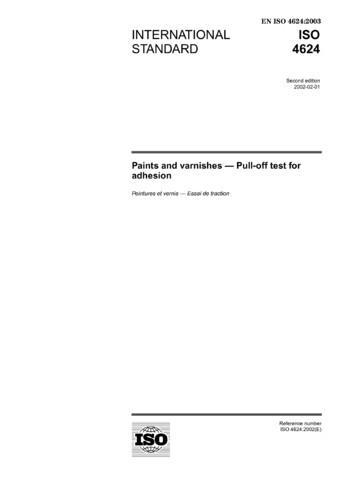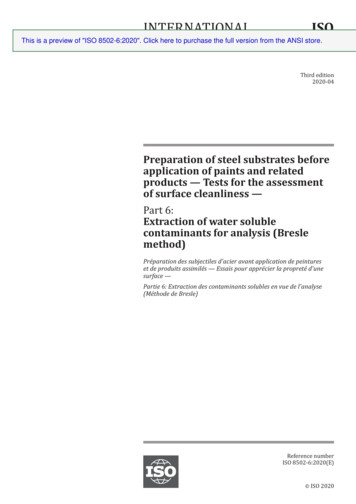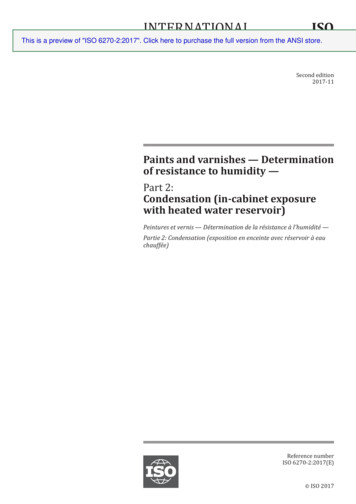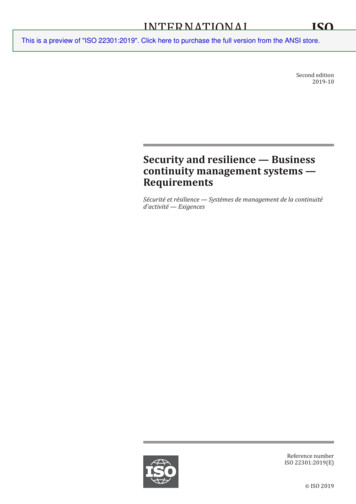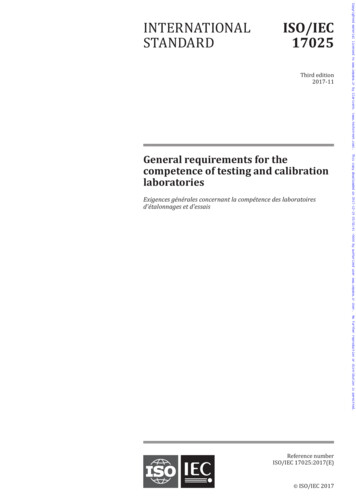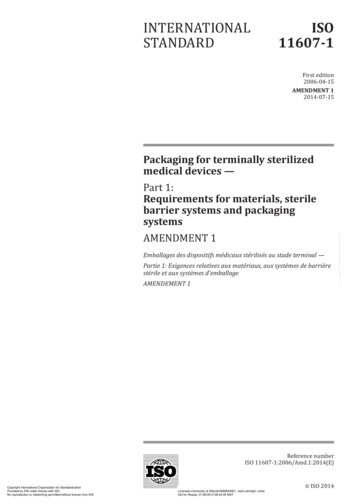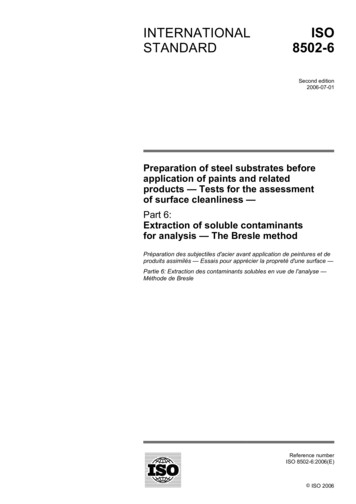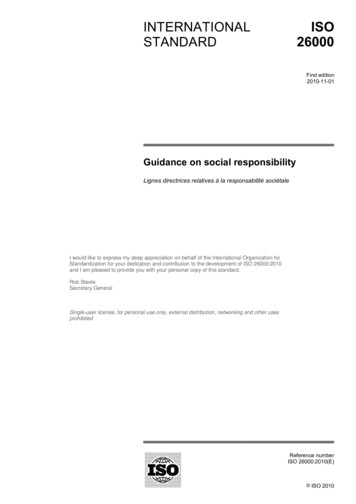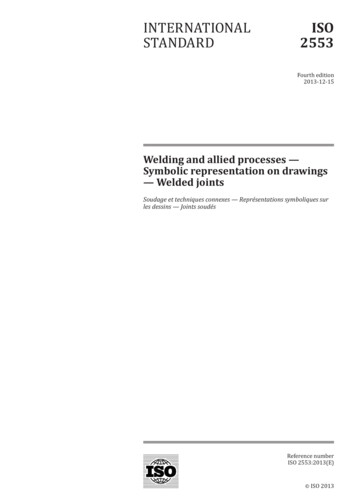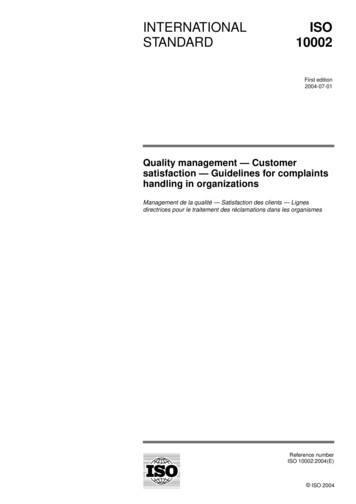
Transcription
INTERNATIONALSTANDARDISO10002First edition2004-07-01Quality management — Customersatisfaction — Guidelines for complaintshandling in organizationsManagement de la qualité — Satisfaction des clients — Lignesdirectrices pour le traitement des réclamations dans les organismesReference numberISO 10002:2004(E) ISO 2004
ISO 10002:2004(E)PDF disclaimerThis PDF file may contain embedded typefaces. In accordance with Adobe's licensing policy, this file may be printed or viewed but shallnot be edited unless the typefaces which are embedded are licensed to and installed on the computer performing the editing. Indownloading this file, parties accept therein the responsibility of not infringing Adobe's licensing policy. The ISO Central Secretariataccepts no liability in this area.Adobe is a trademark of Adobe Systems Incorporated.Details of the software products used to create this PDF file can be found in the General Info relative to the file; the PDF-creationparameters were optimized for printing. Every care has been taken to ensure that the file is suitable for use by ISO member bodies. In theunlikely event that a problem relating to it is found, please inform the Central Secretariat at the address given below. ISO 2004All rights reserved. Unless otherwise specified, no part of this publication may be reproduced or utilized in any form or by any means,electronic or mechanical, including photocopying and microfilm, without permission in writing from either ISO at the address below orISO's member body in the country of the requester.ISO copyright officeCase postale 56 CH-1211 Geneva 20Tel. 41 22 749 01 11Fax 41 22 749 09 47E-mail copyright@iso.orgWeb www.iso.orgPublished in Switzerlandii ISO 2004 – All rights reserved
ISO 10002:2004(E)ContentsPage1Scope .12Normative references .13Terms and definitions .14Guiding principles .24.1 General .24.2 Visibility .34.3 Accessibility .34.4 Responsiveness .34.5 Objectivity .34.6 Charges .34.7 Confidentiality .34.8 Customer-focused approach .34.9 Accountability .34.10Continual improvement .3Complaints-handling framework .45.1 Commitment .45.2 Policy .45.3 Responsibility and authority .46Planning and design .56.1 General .56.2 Objectives .56.3 Activities .66.4 Resources .67Operation of complaints-handling process .67.1 Communication .67.2 Receipt of complaint .67.3 Tracking of complaint .77.4 Acknowledgement of complaint .77.5 Initial assessment of complaint .77.6 Investigation of complaints .77.7 Response to complaints .77.8 Communicating the decision .77.9 Closing the complaint .78Maintenance and improvement .78.1 Collection of information .78.2 Analysis and evaluation of complaints .88.3 Satisfaction with the complaints-handling process .88.4 Monitoring of the complaints-handling process .88.5 Auditing of the complaints-handling process .8 ISO 2004 – All rights reservediii5
ISO 10002:2004(E)8.6Management review of the complaints-handling process .98.7Continual improvement .9Annex A (informative) Guidance for small businesses .10Annex B (informative) Form for complainant .11Annex C (informative) Objectivity .12Annex D (informative) Complaint follow-up form .14Annex E (informative) Responses .17Annex F (informative) Escalation flowchart .18Annex G (informative) Continual monitoring .20Annex H (informative) Audit .22Bibliography .23iv ISO 2004 – All rights reserved
ISO 10002:2004(E)ForewordISO (the International Organization for Standardization) is a worldwide federation of national standards bodies(ISO member bodies). The work of preparing International Standards is normally carried out through ISOtechnical committees. Each member body interested in a subject for which a technical committee has beenestablished has the right to be represented on that committee. International organizations, governmental andnon-governmental, in liaison with ISO, also take part in the work. ISO collaborates closely with the InternationalElectrotechnical Commission (IEC) on all matters of electrotechnical standardization.International Standards are drafted in accordance with the rules given in the ISO/IEC Directives, Part 2.The main task of technical committees is to prepare International Standards. Draft International Standardsadopted by the technical committees are circulated to the member bodies for voting. Publication as anInternational Standard requires approval by at least 75 % of the member bodies casting a vote.Attention is drawn to the possibility that some of the elements of this document may be the subject of patentrights. ISO shall not be held responsible for identifying any or all such patent rights.ISO 10002 was prepared by Technical Committee ISO/TC 176, Quality management and quality assurance,Subcommittee SC 3, Supporting technologies.NOTE ISO 10002 was circulated for vote as DIS 10018. ISO 2004 – All rights reservedv
ISO 10002:2004(E)Introduction0.1 GeneralThis International Standard provides guidance for the design and implementation of an effective and efficientcomplaints-handling process for all types of commercial or non-commercial activities, including those related toelectronic commerce. It is intended to benefit an organization and its customers, complainants and otherinterested parties.The information obtained through the complaints-handling process can lead to improvements in products andprocesses and, where the complaints are properly handled, can improve the reputation of the organization,regardless of size, location and sector. In a global marketplace, the value of an International Standard becomesmore evident since it provides confidence in the consistent treatment of complaints.An effective and efficient complaints-handling process reflects the needs of both the organizations supplyingproducts and those who are the recipients of those products.NOTE Throughout the text of this International Standard, wherever the term “product” is used, it can also mean “service”.The handling of complaints through a process as described in this International Standard can enhancecustomer satisfaction. Encouraging customer feedback, including complaints if customers are not satisfied, canoffer opportunities to maintain or enhance customer loyalty and approval, and improve domestic andinternational competitiveness.Implementation of the process described in this International Standard can— provide a complainant with access to an open and responsive complaints-handling process,— enhance the ability of the organization to resolve complaints in a consistent, systematic and responsivemanner, to the satisfaction of the complainant and the organization,— enhance the ability of an organization to identify trends and eliminate causes of complaints, and improve theorganization's operations,— help an organization create a customer-focused approach to resolving complaints, and encouragepersonnel to improve their skills in working with customers, and— provide a basis for continual review and analysis of the complaints-handling process, the resolution ofcomplaints, and process improvements madeOrganizations may wish to use the complaints-handling process in conjunction with customer satisfaction codesof conduct and external dispute resolution processes.0.2 Relationship with ISO 9001:2000 and ISO 9004:2000This International Standard is compatible with ISO 9001 and ISO 9004 and supports the objectives of these twostandards through the effective and efficient application of a complaints-handling process. It can also be usedindependently of them.ISO 9001 specifies requirements for a quality management system that can be used for internal application byorganizations, or for certification, or for contractual purposes. The process for complaints handling described inthis International Standard can be used as an element of a quality management system.This International Standard is not intended for certification or for contractual purposes.vi ISO 2004 – All rights reserved
ISO 10002:2004(E)ISO 9004 provides guidance on continual improvement of performance. The use of ISO 10002 can furtherenhance performance in the area of complaints handling and increase the satisfaction of customers and otherinterested parties. It can also facilitate the contin
Details of the software products used to create this PDF file can be found in the General Info relative to the file; the PDF-creation parameters were optimized for printing. Every care has been taken to ensure that the file is suitable for use by ISO member bod ies. In the unlikely event that a problem relating to it is found, please inform the Central Secretariat at the address given below .File Size: 523KBPage Count: 32

